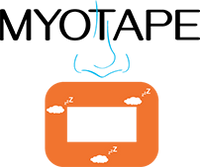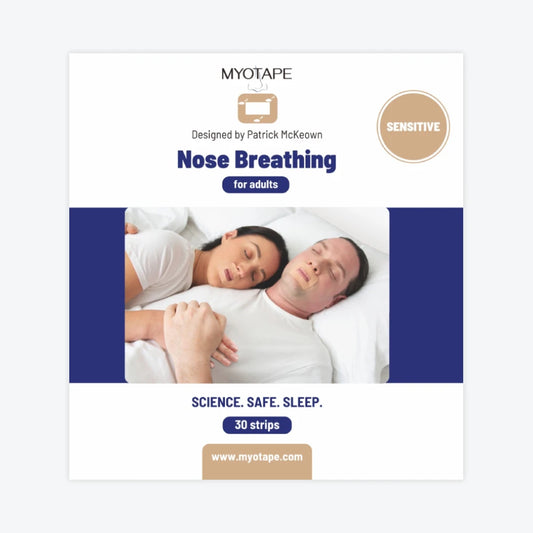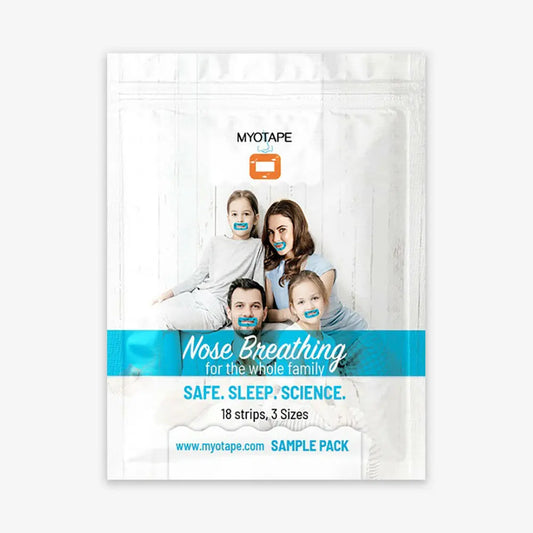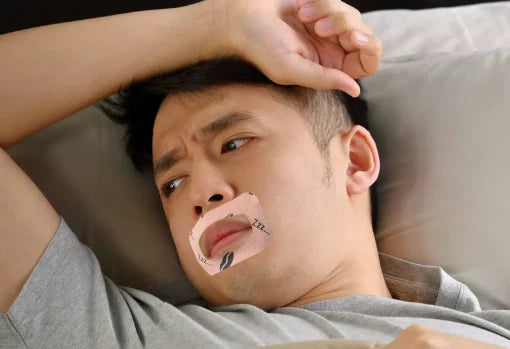If you're using CPAP or a mandibular advancement device (MAD) and waking with a dry mouth, bloating, or discomfort, there's a good chance you're breathing through your mouth during sleep. This isn't just a minor annoyance—it can directly impact the effectiveness of your sleep apnea treatment.
Mouth breathing at night can lead to air leaks, higher pressure requirements, fragmented sleep, and reduced oxygen uptake. But what about using mouth tape? Is it safe? And what kind of tape should you be using?
Why Mouth Breathing Disrupts Sleep
Mouth breathing during sleep doesn't just dry out your mouth—it disrupts sleep quality and reduces the effectiveness of sleep apnea therapy. It can increase air leaks, raise pressure requirements, and lead to fragmented, poor-quality sleep.
According to a large study by Zhang et al. (2021), dry mouth upon waking—a common symptom of mouth breathing—was significantly more prevalent in people with obstructive sleep apnea (OSA).
What Is Mouth Puffing?
Mouth puffing is a reflex that happens when your body tries to force air out through the mouth, often during sleep. It typically occurs when airflow through the nose is limited, and the body seeks another route to release pressure or air buildup.
You may not even know it's happening unless someone points it out or a sleep study detects it. For many people with obstructive sleep apnea (OSA), this unconscious mouth puffing happens right before or after an apnea event.
Mouth puffing isn't subtle. In fact, it's often quite noticeable. The person may be snoring loudly, breathing in through the nose, and forcefully pushing the air out through the mouth. The lips might puff or pout with each breath.
However, when the mouth is sealed shut with traditional tape that covers the lips, it can block this natural reflex. Instead of helping, it may lead to a feeling of suffocation, increased discomfort, or even worsen breathing disturbances during sleep.
Can Mouth Taping Be Dangerous?
Yes—if the tape seals the lips completely.
Traditional mouth tapes that fully close the lips can suppress the body's ability to mouth puff, and are typically unsafe. If the airway is restricted and nasal airflow isn't enough, the inability to release air can lead to increased pressure, air hunger, discomfort, or even worsened breathing disturbances.
This is why it's essential to use a tape that allows airflow when needed.

How MyoTape Supports Safer Mouth Taping
MyoTape is designed with one big difference: the large hole in the middle. Unlike traditional tapes that completely seal the mouth shut or have a tiny hole in the middle, MyoTape wraps around the lips and gently encourages them to stay closed. But if your body needs to puff or release air—especially during an apnea event—it still can.
This makes MyoTape uniquely suited for use with CPAP or MAD devices. It encourages nasal breathing while still allowing airflow through the mouth when needed, especially in cases of increased airway resistance or temporary nasal blockage. In short, it provides the benefits of mouth taping without the risks of total mouth closure.
Scientific Support: What the Research Says
Mouth breathing during sleep is more than a habit; it's often a sign of disrupted breathing patterns. Studies show that mouth breathing can worsen snoring, contribute to sleep fragmentation, and increase the severity of OSA.
A large study by Zhang et al. found that dry mouth upon waking—a sign of mouth breathing—was significantly more common in people with sleep apnea. In a sample of 912 individuals, 54% of snorers reported dry mouth, compared to just 30.5% of non-snorers. In a separate group of 207 patients being screened for OSA, dry mouth strongly correlated with a final diagnosis of sleep apnea. The authors recommended including dry mouth in the widely used STOP-Bang screening tool for OSA (Zhang et al., 2021).
Effectiveness of Mouth Taping
Mouth taping—when done safely—has been shown to reduce symptoms of OSA and snoring. There are even many potential benefits of mouth taping.
- A pilot study by Huang and Young (2022) tested mouth taping in patients with mild OSA who habitually breathed through their mouths. Their Apnea-Hypopnea Index (AHI) dropped from 12 to 7.8 events per hour, and their snoring decreased significantly. ESS (Epworth Sleepiness Scale) scores also improved.
- Labarca et al. (2023) studied the combination of a mandibular advancement device (MAD) and an adhesive mouth tape (AMT). Participants using both saw greater improvement in AHI (from 10.5 to 5.6) compared to MAD alone. 76% reached an AHI under 10 with the combo, compared to just 43% with MAD alone.
- Lee et al. (2023) found that 65% of participants using mouth tape saw their snoring cut by half, and AHI dropped 47%, from 8.3 to 4.7. Supine AHI (sleeping on the back) also improved significantly.
The Controversy: Why Some Experts Are Cautious
Mouth taping, despite its benefits, remains controversial in sleep medicine. Some doctors hesitate to recommend it for two reasons:
- Nasal congestion: If a person can't breathe easily through their nose, sealing the mouth could increase discomfort or risk.
- Mouth puffing: Blocking the mouth completely may interfere with the body's natural need to release pressure or air during sleep.
A 2022 study by Park et al. focused on this second concern: intermittent mouth puffing (IMP). The study included 71 adults with varying levels of OSA. They found a clear relationship between mouth puffing and sleep apnea severity. When the mouth was taped shut:
- 51.72% of participants had improved oxygen desaturation scores.
- 48.28% actually got worse.
Mouth puffing was most common in those with higher BMI and more severe OSA. This suggests that for some people, especially those with heavier airway obstruction, the ability to release air is not just helpful—it's essential.
Why MyoTape Is Safer
Unlike lip-sealing tapes, MyoTape allows mouth puffing. Its unique design supports nasal breathing without fully restricting the mouth. That's why MyoTape is a safer, more flexible choice—especially for people using CPAP or MAD devices, or those who experience mouth puffing during sleep.
With MyoTape, you're not forced into a rigid breathing pattern. You're guided gently toward healthier nasal breathing, while your body retains the freedom to adapt as needed during sleep.
Conclusion: Choosing the Right Mouth Tape for Sleep Apnea
Is mouth taping safe? Yes—when done correctly. The key is not to seal the mouth shut entirely but to support the lips gently while still allowing for airflow. MyoTape does exactly that, making it a suitable option for those with sleep apnea, CPAP users, or anyone trying to make the switch from mouth to nasal breathing.
Combined with breathing retraining methods such as the Buteyko Method, MyoTape can help restore natural nasal breathing, improve sleep quality, and reduce symptoms of sleep-disordered breathing.
FAQs: Mouth Taping and Sleep Apnea
Can you use mouth tape with CPAP or MAD devices?
Yes—but only with a product designed to allow airflow, like MyoTape. Sealing the lips completely can be risky if you experience mouth puffing.
What makes MyoTape different?
MyoTape surrounds the lips and encourages them to stay together, but it leaves the center of the mouth open. This lets you exhale or puff if needed—especially important if you're using CPAP or a MAD.
Is mouth taping safe if I have sleep apnea?
Yes, when done properly. MyoTape allows for both safety and comfort, making it suitable for people with OSA. Always ensure you can breathe freely through your nose before using any mouth tape.
Can I train myself to breathe through my nose at night?
Absolutely. The Buteyko Method can help you restore nasal breathing through breath retraining, nasal unblocking, and calming exercises.
References:
- Zhang, Z., et al. (2021). "Relationship Between Dry Mouth and OSA in Different Sleep Questionnaires." Nature and Science of Sleep, 13:1101-1112.
- Huang, Y., & Young, T. (2022). "Pilot Study on Mouth Taping in Mild Sleep Apnea." Clinical Sleep Medicine Journal, 18(4):857–862.
- Labarca, G., et al. (2023). "The Effect of Adhesive Mouth Strips on CPAP and MAD Outcomes." Sleep and Breathing, 27(1):213–220.
- Lee, H., et al. (2023). "Outcomes of Mouth Taping in Habitual Mouth Breathers with OSA." Sleep Health, 9(2): 164–172.
- Park, J. H., et al. (2022). "Intermittent Mouth Puffing and Mouth Taping in OSA Patients." Journal of Clinical Sleep Medicine, 18(12):2767–2775.








